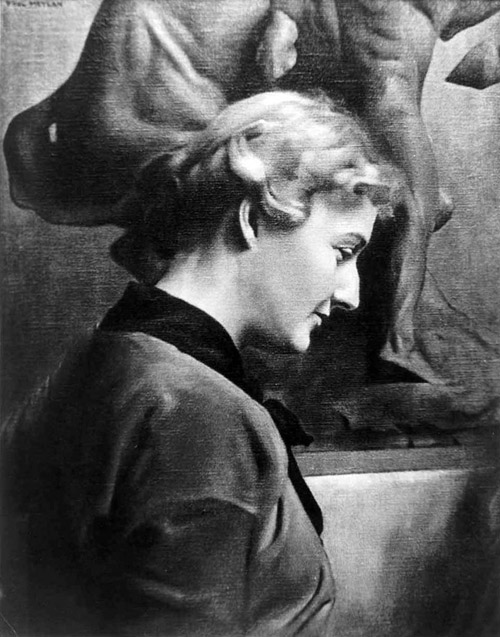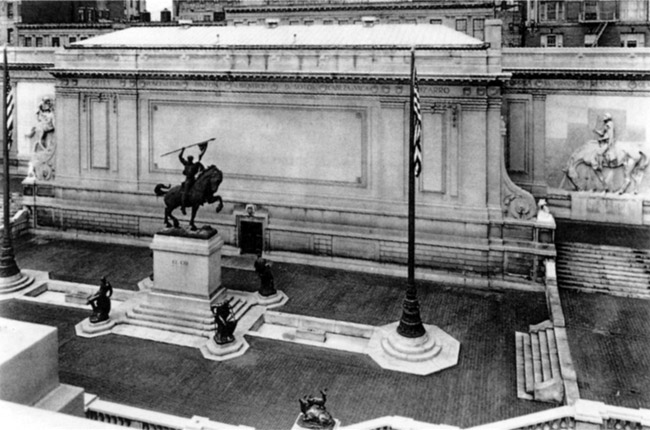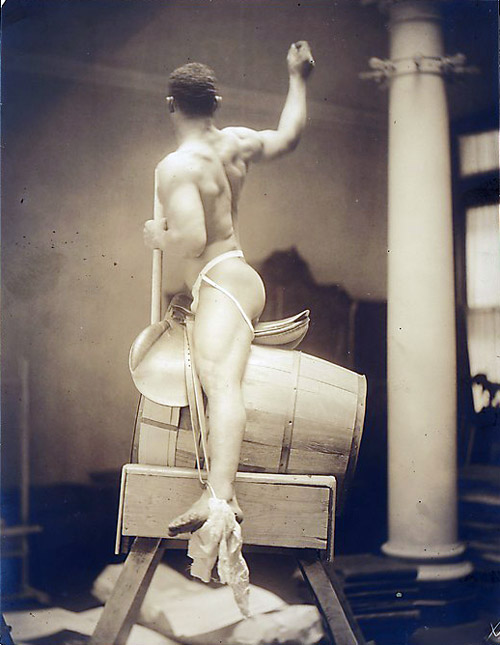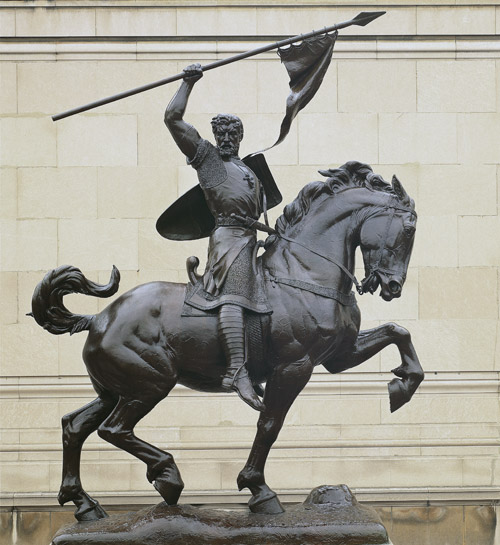The Hispanic Society Sculptural Program
From the outset Huntington envisioned Audubon Terrace as an Academic Acropolis accessible without charge to the public. He intended the proximity of the various societies around a central terraced courtyard to encourage a spirit of collaborative research for scholars. This organized plan of buildings would be made more welcoming to the general public, and enhanced aesthetically, by architectural and freestanding sculpture. Huntington's conception of the public sculpture at Audubon Terrace was related to the Beaux-Arts City Beautiful Movement's aesthetic vision of orderly buildings and sculpture with accessible subject matter, which could elevate public aesthetics and instill moral values. Huntington was actively involved with artists from whom he commissioned sculpture and architectural friezes. The result is an elaborate emblematic program of historical and allegorical imagery infused with a romantic spirit.
 Anna Vaughn Hyatt Huntington, n.d., Smithsonian Institution.
Anna Vaughn Hyatt Huntington, n.d., Smithsonian Institution.Anna Vaughn Hyatt Huntington (1876-1973)
Born in Cambridge, Massachusetts on March 10, 1876, Anna Hyatt was encouraged from an early age to pursue her artistic interests. Her father, Alpheus Hyatt, was an expert scholar in paleontology and zoology who taught at both the Massachusetts Institute of Technology and Boston University, and was a curator at the Boston Society of Natural History.
Her mother, Audella Bebe Hyatt, was a talented landscape artist who assisted her husband by drawing the paleontological diagrams for his books. As a young girl, Anna spent hours at zoos making detailed drawings and later meticulous clay models of all types of animals. Anna's exploration of animal sketching and sculpting was self-directed, because neither her school nor the community of Cambridge offered educational art programs. Her meticulous attention to animal anatomy and the role anatomy plays in determining characteristic movements of animals was rewarded, and by 1900 she was regularly having solo shows. Anna's reputation grew and by 1905 the Metropolitan Museum of Art had purchased two of her sculptures, which were "applauded for their technical virtuosity".1 By 1910 Anna exhibited a monumental equestrian statue of Joan of art in the Paris Salon. It was her first figurative piece to be publically exhibited and won an Honorable Mention.2 The jury was said to have remarked afterwards that the statue would have won first prize had they thought a woman could have created the piece without assistants—a judgment worth noting if not respecting. By 1912, Anna earned $50,000 a year in sculpture commissions and sales, an unprecedented amount for a young woman and only one of twelve women in the entire United States to earn that much.3 Anna worked steadily throughout her life and produced approximately five hundred life-size sculptures, as well as many smaller sculptures and drawings.4
El Cid Campeador
Mounted directly in front of the entrance to the Hispanic Society, the statue welcomes visitors and sets the stage for the Romantic experience of Spanish history awaiting guests inside. Located in front of the north wing building, with only a border decoration carved on the wall behind El Cid, the viewer is confronted with the stark outline of El Cid with no background distractions, creating a powerful encounter with the famous Spanish hero. The design of the statue is unusual. because outdoor sculptures of this era were typically created to be viewed from multiple vantage points, while El Cid is pushed to the edge of the courtyard and surrounded by a balustrade that compels the viewer to look at the statue from only one side. This arrangement may be the result of the narrow confines of the Audubon Terrace courtyard, which limit the possibilities for viewing large sculptures in the round. The unusual artistic consequence is that all of the action and energy that a sculptor would typically disperse in all directions is instead focused along a dynamic axis aligned with the entrance of the Hispanic Society.
 North building and terrace with sculptures by Anna Hyatt Huntington, ca. 1950. HSA.
North building and terrace with sculptures by Anna Hyatt Huntington, ca. 1950. HSA.Rodrigo Diaz de Vivar, or El Cid, is the oldest preserved Spanish epic poem. Based on the military exploits and adventures of the Spanish hero El Cid, who lived during the eleventh century and played a key role in the recapture of Spain from the Moors. His heroic deeds, military might and chivalrous adventures are the foundation of Spanish literature and national myth. El Cid was a Castilian nobleman and military leader in the court of Emperor Alfonso VI of León and Castile. Unfairly exiled from his King's country, the Cid threw himself into Moorish Spain to battle, plunder, and rebuild his name. Eventually the Cid's heroism exploded the King's enmity, and he returned home in glory. For his martial prowess, the Castilian warrior was given the honorific title of Campeador or "challenger." In order to spare lives on both sides, each Spanish army would choose one champion to fight against the other. El Cid's lasting fame stemmed from his role in fighting Moors and traitors to unify Spain. Respected for his use of battlefield tactics based on military maneuvers written by Greek and Roman generals, he also employed psychological fear tactics. His legacy and adventures appear in both Spanish and Arabic literature from the time. Rich in medieval tapestry and flavor, the El Cid adventures depict a less idealized chivalric code than most other literature, for example, despite his high principles the hero is never above deceiving enemies or friends if there is booty to be had.
El Cid's great warhorse Babieca is also known in legends and literature. In some poems, Babieca is thought to have been a gift of King Alfonso from the Babia region in Spain. Other legends record Babieca was a gift from a barbarian and its name derives from "Barbieca" or horse of the barbarian. In any case, Babieca was feared by El Cid's enemies, famous among Christians, and loved by El Cid, who purportedly requested Babieca be buried alongside him.
 Model posing for El Cid sculpture. Metropolitan Museum of Art Accession Number: 1978.662.14.
Model posing for El Cid sculpture. Metropolitan Museum of Art Accession Number: 1978.662.14. El Cid, Anna Hyatt Huntington. HSA.
El Cid, Anna Hyatt Huntington. HSA.The choice of El Cid as the central figure of the courtyard was an inspired decision by Anna Hyatt Huntington. Committed to historical accuracy, which motivated her to create connections between representations of and relics from the past, Anna did research in the Hispanic Society's archives uncovering the physical characteristics of the hero described in the literature of El Cid. She then designed the armor based on Spanish armor worn during the eleventh century and found in the storerooms of the Metropolitan Museum of Art. The figure, armor and physiognomy of the Babieca were the product of her meticulous research. El Cid, however, also serves as a surrogate figure, a romantic hero with an indefatigable sense of adventure, romanticism and unwavering sense of honor—in short, an ideal alter-ego who represents Archer Huntington. The choice of El Cid, moreover, represents Archer Huntington's contributions to scholarship. His (still) authoritative translation of El poema del mio Cid published in 1897 made Huntington a distinguished scholar in his own right. The statue, which symbolizes Huntington's whole museum project, has been subsequently recast and used as diplomatic gifts to other Spanish speaking countries.5
Sonnet inscribed on pedestal from Archer M. Huntington's translation of El Cid:
Renown hath flung her argent portals wide
To greet the star-eyed souls of destiny
And framed in light heroic majesty
Reveals its sumptuous panoply of pride.
These horsemen of the Scroll of Valor ride
Across the sands of time's encrimsoned sea.
What splendid yearning, what high ecstasy
Turned them from commonplace unglorified!
From shadowed hours they gazed upon the sun,
The burning fields of visions dared to tread,
And laurelled courage hath achieved its lot.
O Masters, needs we serve ye one by one;
As moving torches are the flaming dead
To light the paths for souls that are forgot.
Castilian Warriors, 1927
Four larger than life bronze warriors sit in various positions on the base of the El Cid statue. Each warrior leans or sits with his shield in a different position. Their distinct stances can be interpreted as differing attitudes towards battle.
Don Quixote, Limestone Relief, 1942
Mounted on the west courtyard to the right hand side of El Cid and facing the entrance to the Hispanic Society, a larger the life pair of limestone bas-relief sculptures creates a harmonious balance with each other, while simultaneously framing the El Cid statue. With Don Quixote, Anna Huntington thematized fidelity to one's own inner vision, apparently a subject especially dear to her. Don Quixote is depicted sitting upright with his held tilted up, his gaze seemingly fixed on the spiritual inner vision which compels him beyond his human imperfection. He is absorbed in his visionary dreams while his horse nibbles at thistles on the ground. Anna Huntington created multiple versions of Don Quixote, found in various museums around the country. Each one takes a slightly different approach and emphasis, yet all are about the same idea: maintaining idealism despite political defeat and social failure.
The themes associated with Don Quixote would have been particularly resonant in the midst of World War II, when the statue was unveiled. Archer Huntington's buildings and Anna's art share similar characteristics in this regard. In contrast to the then dominant idea of abstract "art for art's sake," the Huntingtons felt a keen responsibility to create art that would inspire a broad range of people with accessible and realistic subjects. The art and architecture Archer and Anna built was designed to inspire and elevate the spirit – to serve as a reminder of the better side of humankind, which continually fights and strives for good even when it seems hopeless. Both Archer and Anna wanted to guard and fight for the values of idealism and humanism they feared were being forgotten or ignored.
Poem by Archer M. Huntington inscribed under Don Quixote:
Shall deeds of Caesar or Napoleon ring
More true than Don Quixote's vapouring?
Hath winged Pegasus more nobly trod
Than Rocinante stumbling up to God?
Boabdil, 1943
Mounted on the west courtyard wall to the left hand side of El Cid, and facing the entrance to the Hispanic Society, is a larger than life limestone bas-relief of Boabdil the last Moorish king of Spain. The expulsion of the last Moorish king from the last Moorish Kingdom by the Christian armies of Ferdinand and Isabella brought an onslaught of strong Catholic influence to Spain and heralded a new era. But the seven centuries of Moorish influence meant Islamic culture was, and remains forever, intricately woven into Spanish history and the national psyche.
Anna Huntington's representation of the noble but disheartened Moor captures his complexity. Boabdil is depicted in his exotic robes and boots riding his horse up the mountain and away from Spain, his expression one of mixed sorrow, rage and disheartened spirit.
Boabdil adds a complex romantic character to the Spanish history and legends represented in front of the Hispanic Society. The sculpture also alludes to events in Spanish history that had occurred only recently when it was created: the Spanish Civil War and the loss of Spain's last colonies. In Anna Hyatt's opinion, just as Boabdil had fought nobly yet been defeated, twentieth-century Spain failed in a gallant fight to maintain her Empire and spread Catholicism.
Poem by Archer M. Huntington inscribed under Boabdil:
He wore a cloak of grandeur. It was bright
With stolen promises and colours thin,
But now and then the wind—the wind of night—
Raised it and showed the broken thing within.
Bronze Flagpole Bases, installed 1928
Designed in the Renaissance manner with a multi-figured composition rising from muscular warriors and horses engaged in battle, followed by praying monks and religious men, to allegorical figures representing the arts, the bronze flagpole bases symbolize the cultural ascendancy from chaos to religion to art.
Though Anna Hyatt remained dedicated to a traditional, academic, and realistic style in her work, she was nevertheless a pioneer in her use of new materials. She was the first major American sculptor, for example, to use aluminum. When asked why she chose aluminum, Anna Hyatt replied that she believed it was more vibrantly luminous than bronze.6 In 1925, Bethold Nebel, the sculptor who was responsible for creating the large bronze doors to the Hispanic Society and Numismatic Museum, created an enlarging machine that employed the "scrape method". Models of any size could be enlarged with more accuracy than had been possible using the "point" system, which had been in use since ancient Greece. For life-size and larger-than-life-size sculptures, Anna engaged Nebel and his new system of enlarging. Anna Hyatt typically began by creating a clay model roughly nine to twelve inches in height. This was then scaled up to 1/4 life-size, then 1/2 life-size. At each stage, adjustments would be made. Such statues were assembled with scaffolding and platforms built around them, so Anna Hyatt could examine the entire work and decide on which changes should be made. Because her sculptures were so large, it was difficult to make minor adjustments to small areas. The sculptures, made in parts, would therefore be disassembled separate parts reworked and recast when necessary, and the sculptures finally reassembled.
1 Works "Winter Noon" and "Tigers Watching" were commented on by Clarence Hoblitzell, "Collection of Bronzes in the Metropolitan Museum" in, ‘The Sketch Book, VI (December 1906): 186.
2 Anna paid keen attention to historical accuracy and relationships. Joan of Arc and the horse's amour were created according to historical sources. The base of the statue was built with stones taken from the cell at Rouen where Joan was kept prisoner. And the pedestal of the statue is composed of fragments of pilaster from Rheims Cathedral where Charles VII coronation took place.
3 Anna Hyatt Huntington Oral History Interview conducted by Dorothy Seckler in Connecticut on December 14, 1964.
4 Edward Laroque Tinker, The Hispanic Society of America, 1958. 2. Reprinted by permission from THINK Magazine by International Business Machines Corporation. Series IV, Box 1. Published Material 1958-60. AHH Papers.
5 Versions of the statue can also be found in front of the San Francisco Museum of Legion of Honor and the San Diego Museum.
6 Cerinda W. Evans, Anna Hyatt Huntington. The Mariners Museum. Newport News, Virginia, 1965. p42.